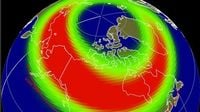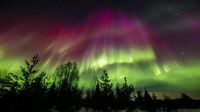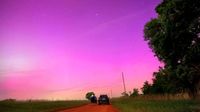Skywatchers across the northern United States are gearing up for a spectacular display of the aurora borealis, or Northern Lights, on the night of April 16, 2025. Following a series of strong solar storms, this natural phenomenon is expected to be visible further south than usual, possibly as far as mid-Michigan and even parts of New Jersey.
The aurora borealis, known for its dazzling colors of green, red, and purple, occurs when charged particles emitted by the sun collide with gases in Earth’s atmosphere. This collision creates the stunning light displays that mesmerize viewers. According to NOAA's Space Weather Prediction Center, a strong geomagnetic storm has intensified the visibility of the auroras, making this week an exceptional time for skywatchers.
On the night of April 15, the Northern Lights were already visible in Canada, Alaska, and several U.S. states, including Washington, Idaho, Montana, North Dakota, Minnesota, and Wisconsin. However, many Americans will have a second opportunity to witness this celestial event on April 16, 2025. The viewing line is expected to extend as far south as the Illinois-Wisconsin border, with potential sightings in parts of Michigan and even New Jersey.
For optimal viewing, experts recommend heading out of city limits to areas with minimal light pollution. The best time to catch the auroras is typically between 10 p.m. and 2 a.m. local time, although this can vary based on solar activity and weather conditions. Clear skies are crucial for visibility, and forecasts indicate that many regions, including Michigan, will enjoy favorable conditions on Wednesday night.
In Michigan, clear skies are anticipated, particularly in the northern parts of the state, providing excellent opportunities for residents to witness the auroras. The National Weather Service in Grand Rapids has confirmed that conditions will be ideal for viewing, with clear skies expected across much of the state.
Furthermore, NOAA has reported that the geomagnetic storm expected on April 16 is classified as G3, indicating strong activity that could affect satellite navigation and radio frequencies. Such storms can produce vibrant auroras that are visible from up to 1,000 kilometers away when conditions are right. The Kp index, which measures geomagnetic activity, is forecasted to range from 3.33 to 5.33, suggesting a good chance for visible auroras.
For those in New Jersey, the potential for aurora sightings is also promising. A strong solar storm has created conditions that could allow the Northern Lights to be seen as far south as New Jersey. Experts advise that the best viewing opportunities will occur around midnight, with NOAA providing real-time updates on aurora visibility via their website.
While the northernmost states like Alaska typically offer the best views of the auroras, this week’s solar activity has pushed the visibility further south. The auroras’ reach may extend into states like Pennsylvania, New York, New Hampshire, Vermont, and Maine, with the best chances occurring on the night of April 16.
As skywatchers prepare for this celestial event, it's essential to keep in mind that auroras can be unpredictable. Experts have noted that even the most accurate forecasts can change rapidly, sometimes within a half-hour window. Therefore, those hoping to see the Northern Lights are encouraged to stay updated on the latest forecasts and be ready to venture outside at a moment's notice.
In addition to the visual spectacle, the increase in solar activity is a reminder of the sun's 11-year solar cycle, which is currently peaking in 2025. This heightened activity not only increases the chances of auroras but can also impact technology on Earth, including power grids and communication systems.
For anyone hoping to photograph the Northern Lights, experts suggest several tips. Utilizing a smartphone's Night Mode can enhance the chances of capturing the auroras, while using a tripod can help stabilize the camera for long-exposure shots. For those with digital cameras, settings such as a low f-number and an ISO between 100 and 800 can yield impressive results.
As the excitement builds for the upcoming display, skywatchers across the northern U.S. are reminded to take advantage of this rare opportunity. Whether you are in Michigan, New Jersey, or any other state within the viewing range, prepare for an unforgettable night under the stars.
In summary, the aurora borealis is set to light up the night sky across many parts of the United States on April 16, 2025, thanks to a powerful solar storm. With clear skies expected in many areas and the viewing line stretching further south than usual, this is a chance that skywatchers won’t want to miss.









